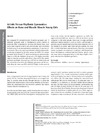Identificador persistente para citar o vincular este elemento:
https://accedacris.ulpgc.es/jspui/handle/10553/48973
| Título: | Artistic versus rhythmic gymnastics: Effects on bone and muscle mass in young girls | Autores/as: | Vicente-Rodriguez, German Dorado, C. Ara, I. Perez-Gomez, J. Olmedillas, H. Delgado-Guerra, S. Calbet, J. A. L. |
Clasificación UNESCO: | 241106 Fisiología del ejercicio | Palabras clave: | Physical fitness Children - exercise - training - hypertrophy Exercise - training - hypertrophy Training - hypertrophy Hypertrophy |
Fecha de publicación: | 2007 | Editor/a: | 0172-4622 | Publicación seriada: | International Journal of Sports Medicine | Resumen: | We compared 35 prepubertal girls, 9 artistic gymnasts and 13 rhythmic gymnasts with 13 nonphysically active controls to study the effect of gymnastics on bone and muscle mass. Lean mass, bone mineral content and areal density were measured by dual energy X-ray absorptiometry, and physical fitness was also assessed. The artistic gymnasts showed a delay in pubertal development compared to the other groups (p < 0.05). The artistic gymnasts had a 16 and 17 % higher aerobic power and anaerobic capacity, while the rhythmic group had a 14 % higher anaerobic capacity than the controls, respectively (all p < 0.05). The artistic gymnasts had higher lean mass (p < 0.05) in the whole body and the extremities than both the rhythmic gymnasts and the controls. Body fat mass was 87.5 and 61.5 % higher in the controls than in the artistic and the rhythmic gymnasts (p < 0.05). The upper extremity BMD was higher (p < 0.05) in the artistic group compared to the other groups. Lean mass strongly correlated with bone mineral content (r = 0.84, p < 0.001), and multiple regression analysis showed that total lean mass explained 64 % of the variability in whole body bone mineral content, but only 20 % in whole body bone mineral density. Therefore, recreational artistic gymnastic participation is associated with delayed pubertal development, enhanced physical fitness, muscle mass, and bone density in prepubertal girls, eliciting a higher osteogenic stimulus than rhythmic gymnastic. | URI: | https://accedacris.ulpgc.es/handle/10553/48973 | ISSN: | 0172-4622 | DOI: | 10.1055/s-2006-924397 | Fuente: | International Journal Of Sports Medicine[ISSN 0172-4622],v. 28 (5), p. 386-393 |
| Colección: | Artículos |
Citas SCOPUSTM
48
actualizado el 08-jun-2025
Citas de WEB OF SCIENCETM
Citations
45
actualizado el 08-jun-2025
Visitas
362
actualizado el 27-sep-2025
Descargas
738
actualizado el 27-sep-2025
Google ScholarTM
Verifica
Altmetric
Comparte
Exporta metadatos
Los elementos en ULPGC accedaCRIS están protegidos por derechos de autor con todos los derechos reservados, a menos que se indique lo contrario.
